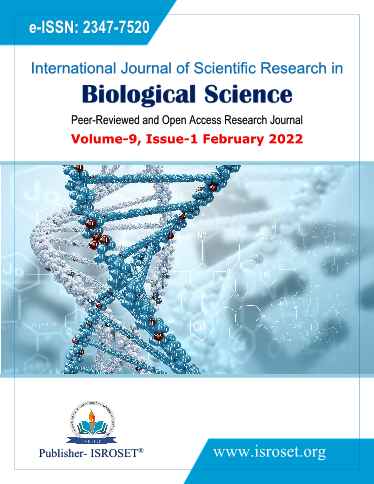Species Composition, Abundance and Diversity of Lakeshore Birds in Lake Mainit, Agusan del Norte, Philippines
Keywords:
Lakeshore Birds, Species Composition, Abundance, Diversity, Lake MainitAbstract
The aim of this study was to assess the avifaunal diversity of lakeshore birds in the three (3) municipalites of Lake Mainit, Agusan del Norte, Philippines namely Jabonga, Kitcharao and Alegria. It was conducted in fourteen (14) transects for a total of sixty-four (64) hours. Birds were recorded and identified using field guides, visual encounter and bio-acoustic cues. A total of one thousand one hundred twenty eight (1128) individual of birds were documented and resolved into twenty-nine (29) species of lakeshore birds belonging to fourteen (14) families. Ardeidae listed the most number of species seen viz., Purple Heron (Ardea purpurea), Eastern reef-egret (Egretta sacra), Little egret (Egretta garzetta), Javan pond-heron (Ardeola speciosa), Black-crowned night heron (Nycticorax nycticorax), Cattle egret (Bubulcus ibis), Yellow bittern (Ixobrychus sinensis) and Cinnamon bittern (Ixobrychus cinnamomeus). The Common Tern (Sterna hirundo), Javan pond-heron (Ardeola speciosa), Glossy swiftlet (Collocalia esculenta) and Asian glossy starling (Aplonis panayensis), were the most abundant species with a relative abundance of 26.4%, 14.9%, 11.4% and 6.0% respectively. The Cinnamon bittern (Ixobrychus cinnamomeus) and Common Moorhen (Gallinula chloropus) were the least abundant species having 0.08% relative abundance and was encountered once all throughout the survey. Simpson’s index was high at Transect VIII (0.462) and low at transect V (0.089). Based on the IUCN Red List of Threatened Species criteria, one species was considered Vulnerable- the Silvery Kingfisher (Alcedo argentata). This study recommends additional surveys in the areas not covered by this study and a local campaign for the conservation of these lakeshore birds must be implemented to protect and conserve species considered as “vulnerable”.
References
B. Khanal, “Ecological Study of Helminth Parasites in Fishes”, Our Nature, 1(1), 67-68, 2006.
G. B. Villamor, “A Survey and Study On Food Habits Of Migratory Waterbirds Along Naujan Lake, Oriental Mindoro Province, Philippines”, Journal of Tropical Biology & Conservation (JTBC), 2(1), 10-17, 2006.
G. L. Alviola, B. I. Del Rosario, J. B. Otadoy, J. C Ibanez, “Birds of Malagos Watershed, Southeastern Philippines”, Asian Journal of Biodiversity, 1(1), 2010.
W. J. Mitsch, J. K. Cronk, “Creation and restoration of wetlands: some design consideration for ecological engineering”, In Soil restoration, Springer, New York, NY.pp. 217-259, 1992.
W. MacKenzie, A. Banner, “ A classification framework for wetlands and related ecosystems in British Columbia”, Province of British Columbia, Ministry of Forests Research Program, p.16, 2001.
A. Gibru, G. Mengesha, “Species composition, seasonal abundance and distribution of avifauna in Lake Hawassa and part of the Eastern Wetland habitats”, Southern Ethiopia. International Journal of Biodiversity and Conservation, 13(1), 1-11.
R. C. Gupta,T. K. Kaushik, “Insight into wetland winter migratory avian biodiversity in Hathnikund Barrage in Haryana State in India”, International Journal of Life Sciences, 5(1), 39-43, 2011.
N. A. D. Mallari, B. R Tabaranza, “Key conservation sites in the Philippines”, A Haribon foundation & BirdLife International directory of important bird areas, Bookmark, Inc., Philippines, p. 193, 2001.
K. Sonobe, S. Usui, “A field guide to the waterbirds of Asia”, Wild bird society of Japan, Pemberly Books, Tokyo, pp. 11-46, 12, 1993.
O. Venter, N. N. Brodeur, L. Nemiroff, B. Belland, I. J. Dolinsek, J. W. Grant, “Threats to endangered species in Canada”, Bioscience, 56(11), 903-910, 2006.
S. Takele, G. Endale, “Species composition and relative abundance of Lakeshore bird species around Lake Hawassa, Ethiopia”, International Journal of Biodiversity and Conservation, 11(6), 175-182.
M. Mola, D. Ejigu, Y. Yitayih, “Species Composition, Relative Abundance, and Habitat Association of Avifauna in Zegie Peninsula Forest Patches and Associated Wetlands, Bahir Dar, Ethiopia”, International Journal of Zoology, p. 12, 2001.
A. E. Jensen, “Conservation of seabirds and threatened avifauna in the Cagayan Ridge Marine Biodiversity Conservation Corridor, the Sulu Sea, Philippines”, With notes on the occurrence of seabirds in the Balabac and the Tri-national Sea-turtle Marine Biodiversity Conservation Corridors, Conservation International, Philippines, 2007.
A. Berg, “Diversity and abundance of birds in relation to forest fragmentation, habitat quality and heterogeneity”, Bird study, 44(3), 355-366, 1997.
J. H. Connell, R. O. Slatyer, “Mechanisms of succession in natural communities and their role in community stability and organization”, The american naturalist, 111(982), 1119-1144, 1997.
S. S. Rosenstock, D. R. Anderson, K. M. Giesen, T. Leukering, M. F. Carter, “Landbird counting techniques: current practices and an alternative”, The Auk, 119(1), 46-53, 2002.
R. Kennedy, P. C. Gonzales, E. Dickinson, H. C. Miranda Jr, T. H. Fisher, “A guide to the birds of the Philippines”, Oxford University Press, England, pp. 110-150, 2000.
Ibid (17).
Downloads
Published
How to Cite
Issue
Section
License

This work is licensed under a Creative Commons Attribution 4.0 International License.
Authors contributing to this journal agree to publish their articles under the Creative Commons Attribution 4.0 International License, allowing third parties to share their work (copy, distribute, transmit) and to adapt it, under the condition that the authors are given credit and that in the event of reuse or distribution, the terms of this license are made clear.







